ITTF – from strength to strength with online video strategy
The International Table Tennis Federation (ITTF) is the governing body for 226 worldwide associations and oversees more than 120 international events. It is one of the largest sports federations in the world and has a proud history, having organised the World Table Tennis Championships since 1926.
Our partnership with the ITTF started back in 2017 and has since gone from strength to strength. Today, Tellyo is integral to the ITTF’s direct-to-fan video strategy, enabling the federation to stream matches and share clips
from tournaments previously difficult to access for fans across the globe.
Increased global streaming collaborations
Starting with one trial tournament in 2017, Tellyo now supports all of the ITTF’s major tours and championships. More recently, our platform has been used during regional events in remote locations within Fiji, Nigeria and India.
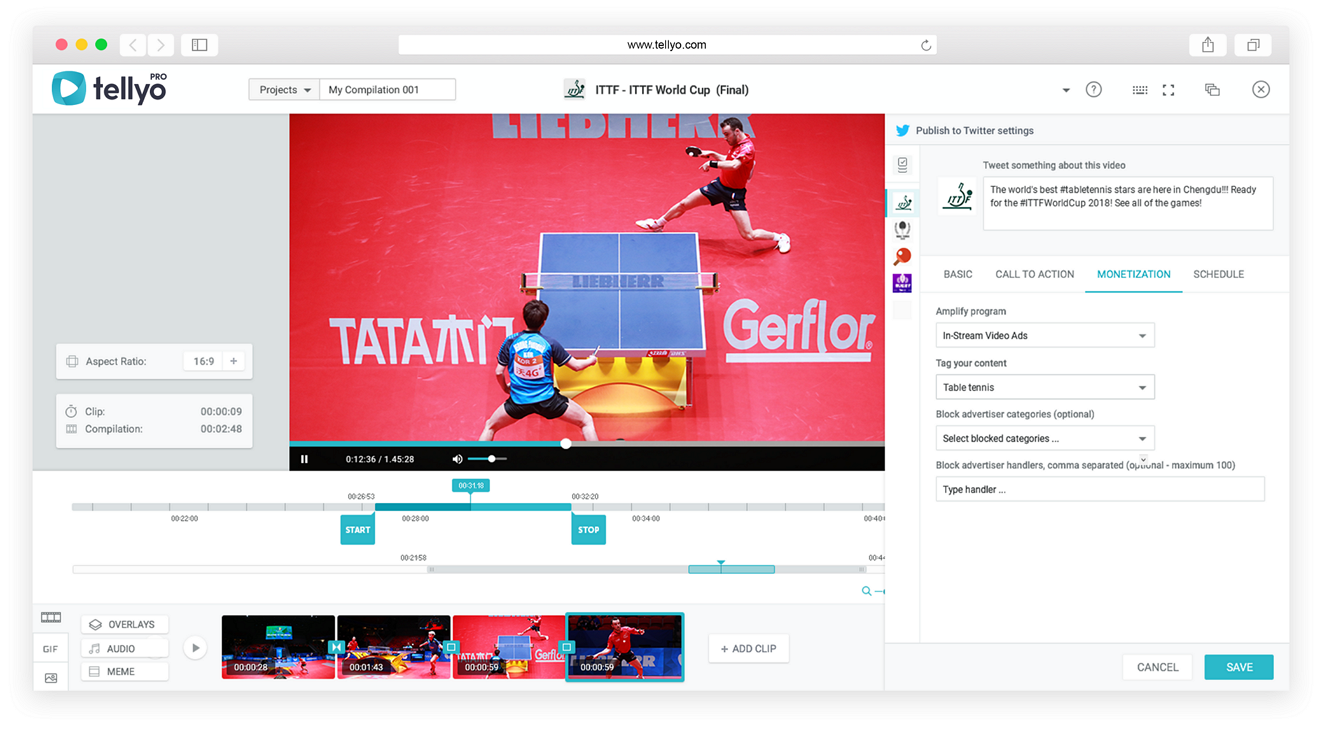
When working in remote locations, the ITTF rely on us to seamlessly deliver streamed content to global fans online. The key to our success is two-fold. Firstly, our platform’s infrastructure is capable of receiving signals from anywhere in the world, however remote, thanks to the network of servers we use. Secondly, we provide an extensive set of advanced tools to ITTF production teams, expertly meeting their various technical requirements.

Video clips further boosting engagement with the ITTF
With a greater number of tournaments being covered, the ITTF is seizing these opportunities to create more video clips for its social media channels. In turn, these clips help to drive viewers to its live stream and are having a hugely positive impact on overall engagement with the federation and table tennis online.
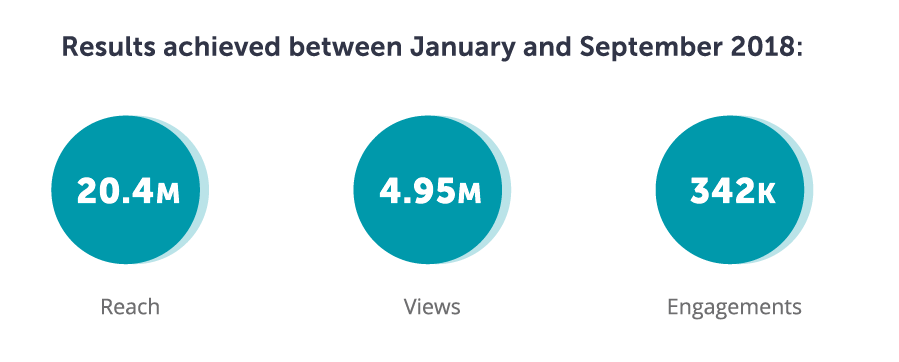
“I cannot imagine life without Tellyo. The platform is at the core of our social video strategy, helping us to showcase dynamic sports content from multiple ITTF tournaments online. All-in-all, thanks to Tellyo, we’re better able to entertain and excite our fans, dramatically improving our digital reach, video views and fan engagement levels across social media.”

The most common live video streaming habits of digital audiences
It’s extremely difficult to pin down live video streaming audiences. Data will vary depending on world regions, such as a country’s internet quality, its level of technology adoption and development, and so on. However, a new report has done an incredible job of helping us to build a better understanding of digital viewers, as much as it’s possible.
The IAB (Interactive Advertising Bureau) report – Live Video Streaming: A Global Perspective – provides a great benchmark regarding trends across live video streaming. It’s a must read for anyone interested in the broadcasting industry and for people who want to stay up to date with the most recent studies. Here’s a short, but insightful summary of the survey’s results.
Check out our other stories:
- Ideas for online video content when you can’t show games
- Will the real host of the 2022 FIFA World Cup be the web?
- Still looking for a prime alternative to Snappy TV?
An overview of live video streaming consumption
The IAB report highlights that we are all surrounded by devices that enable us to watch video streams – such as PCs, laptops, smartphones, tablets and web connected TVs, all of which are some of the most common screens we use to catch the content we want to see.
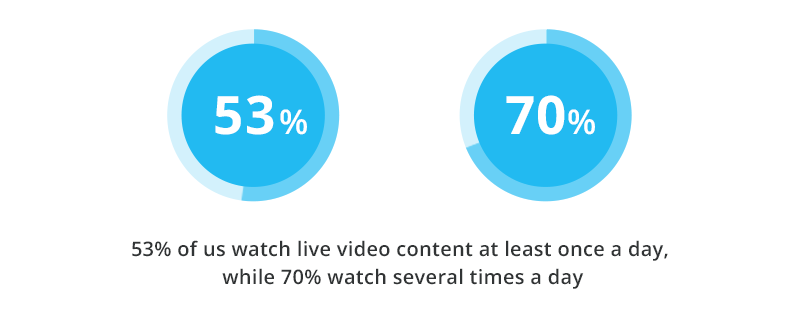
The report also makes a strong point that video streaming is still growing rapidly. Forty-seven per cent of people who took part in the IAB survey said that they stream more videos in 2018 than they did a year ago. Russians are a model example of what the report calls the ‘video thirsty user’, as 61% of Russian respondents said they watch more streams now than a year ago.
How we watch content
Out of all of our web-connected devices, smartphones are the most popular when it comes to watching video streams (for 62% of survey respondents). In second place comes the PC/laptop, while tablets come third. The reports notes that the most popular ways to watch video streams is further reflected in the devices people keep at home, as listed below.
“What device I own or have access to”:
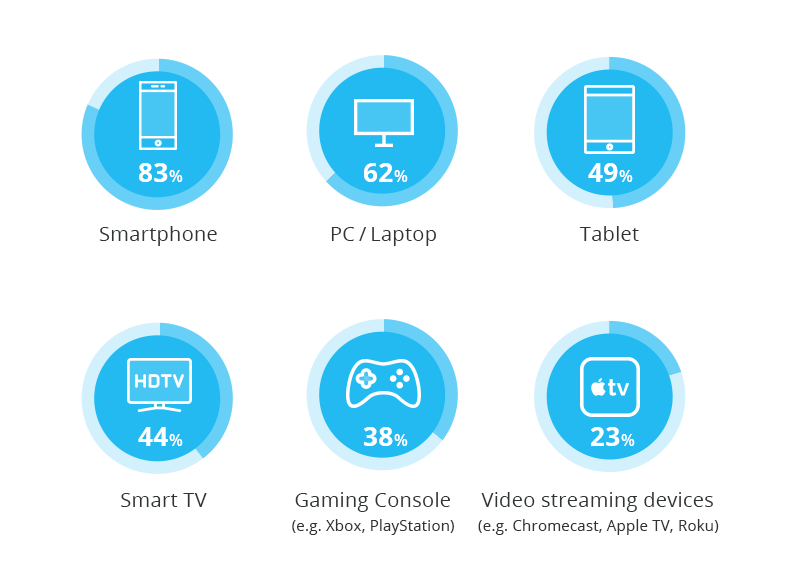
The ever-present smartphone is noted as the device on which we watch live video content most frequently – 67% of respondents use them at least once a day or several times a day. In terms of use, the second device is a Smart TV, while tablets and video streaming devices (Chromecast, Apple TV) come joint third.
However, while we might use smartphones to watch live video content most often, the report concludes that the device is not the best platform for longer formats.
It seems that audiences around the world prefer to watch long formats, or videos for longer periods of time, on bigger screens. The Smart TV comes top with 67% watching more than 30 minutes of live streams daily; while video streaming devices (that are connected to and watched through a TV) follow closely behind on 62%. Only in 47% of cases are smartphones used to watch video for 30 minutes or more.
Audiences prefer to watch longer video content on bigger screens, while smartphones are often used for short videos no longer than 10-30 minutes in length.
Where we consume content
Social media now plays a key role in many areas of life. Unsurprisingly, viewers like to watch live streams mostly on social media (52%), with dedicated, digital streaming platforms with subscriptions coming in second place (41%).
The report highlights that social platforms are a natural place for streaming and probably one of the best places for viewing:
- (Almost) everyone can access social media streams, as long as they have a web connection.
- Social media is free to use.
- Social channels are widely accessible via almost any web-enabled device you can imagine: PCs, smartphones, tablets, Smart TVs, gaming consoles etc.
- Social offers specific features that help broadcasters to promote and inform users about a stream.
- Users also benefit from specific features, such as the ability to chat during a stream.
Digital streaming subscription platforms, like Hulu Live or DirectTV Now, are dedicated to digital entertainment and offer access to multiple TV channels using a connected device. Users can watch anywhere, either live or on-demand at a more convenient time.
Other, popular sources of live video streams are:
- TV network websites or apps (like ITV Hub, All4 or other web services that provide live streams from traditional TV broadcasters) – 34%
- Gaming websites or apps – 33%
- Paid TV service provider website or app – 21%
- Other sources – 9%
Content we like to consume
The most popular type of content that is streamed by digital viewers around the world is the TV series (for 45% of users).
Thirty-one per cent watch live sports, with 30% tuning into how-to tutorials. Gaming fans represent 29% of live video content consumers. What’s interesting is that live videos made by friends or family members are appealing to 28%; while news is interesting for 27%, videos made by an online celebrity or influencer for 24%, live concerts for 23% and talk shows for 22%.

There isn’t anything too surprising about the above types of content we like to consume. For most people, a box-set TV serial is the go-to content across the web in general, including video on-demand (VOD) and live streaming services. Live sports events are then an obvious second, as sport is all about being ‘in the moment’.
Where we consume
Gone are the days of a TV set in every room, probably forever. Live content is now everywhere, across laptops, smartphones and tablets to name just a few. These new screens are often the first thing we look at in the morning and, quite probably, the last thing we look at before going to sleep.
According to the IAB report, 73% of live video content is consumed at home. Outdoor consumption appears to be alongside journeys and social events, like going to a restaurant, bar or the park, or on the way to work and while shopping.

Thirty-seven per cent of viewers spend 81% or more of their time live streaming in the company of others, which increases to 56% of viewers when using a smartphone. This is worth remembering, as it means that up to just over half of your streaming audience will be more than one person, depending on the device being used.
How we multi-task while watching live streams
While watching live streams an audience’s attention is highly distracted. But this doesn’t mean that they don’t pay attention to what they see on the screen. In fact, while they will do other things, these are more often related to what is being watched.
Things (related to what is being watched) that viewers do while watching live content:
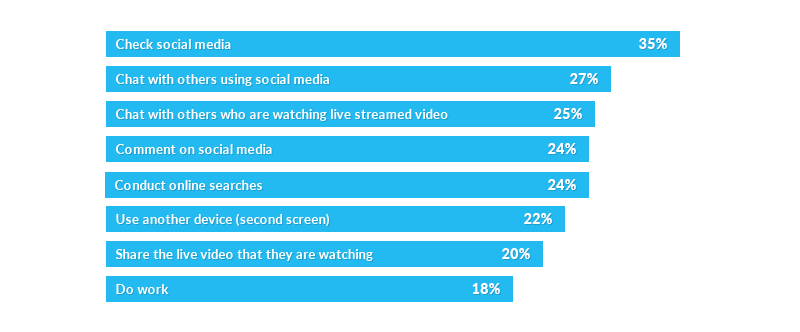
Why we watch live streams
So, what exactly does an audience look for in a live stream? The IAB report asked respondents – What are the main reasons for you to watch live video streaming content? – and the responses shed light on why we watch:
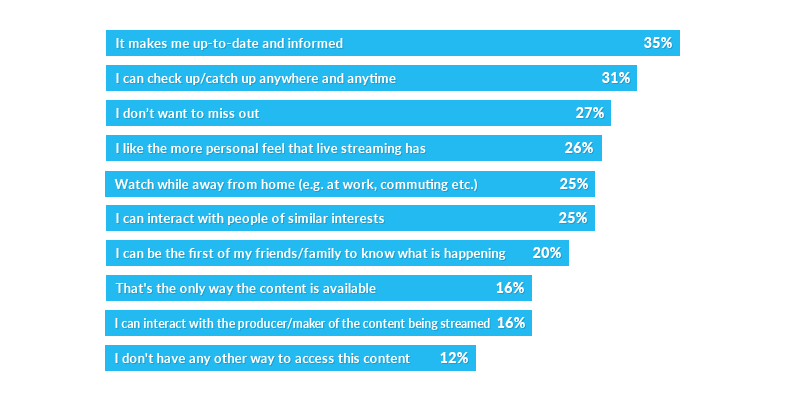
Something that should be of valuable insight to many live content industry professionals, the report also asked: Which of the following factors influence your choice of live video streaming sources?
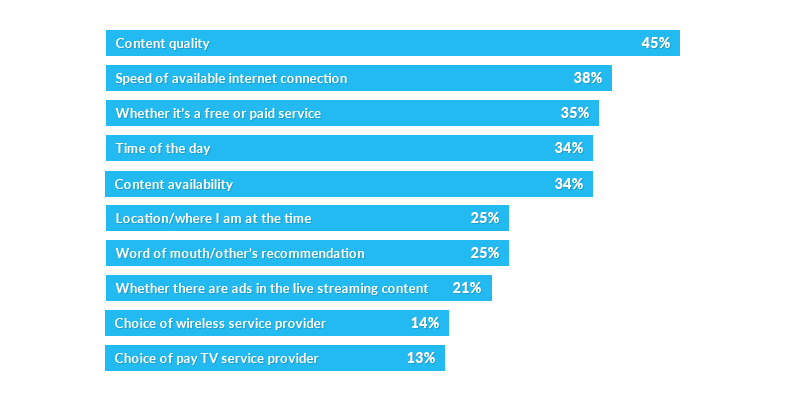
It seems that technical aspects, such as content quality and the speed of connection, are crucial here, while ads (or the absence of ads) in a live stream are not so important after all.
Key takeaways about the live video consumer
Based on the IAB report’s survey results, if we were to create a persona for the ‘live video content consumer’, the following would form their habits and thoughts. They would:
- Watch live video content a couple of times a day
- Own a smartphone and use it to stream live video content
- View streams via social media channels
- Favour TV serials and sports
- Enjoy watching live streams in the late evening – from 8pm to 11pm
- Check social media and look for related online content while watching a stream
- Appreciate content quality and connection speed
- Like how live content makes them feel up to date and well informed
Although the above makes some pretty big generalisations, once you start to glean new insights from reports such as the IAB’s, then you can build a better picture of the live video content consumer. Worth remembering!
Reaching the live video streaming consumer
When it comes to execution of your live video strategy and getting the tools to reach the live video consumer described above, simply try one of our Tellyo solutions. Tellyo Pro is for regular, extensive broadcasts; while Tellyo On Demand is designed for more occasional use. If you’re not sure which solution would suit you, please get in contact and the team here will be more than happy to help.
What makes real-time sports videos engaging?
It’s a good question to pose: what does make a real-time sports video engaging? Having worked with the International Table Tennis Federation (ITTF) for a year now, we feel we’ve developed a deeper understanding from what they’ve created and shared through our platform.
In this blog, we’ll take a look at some of the ITTF’s best moments of 2017 – a year that was truly amazing for the organisation, the players and the sport itself. Here at Tellyo, we’re extremely proud to work with the ITTF – the largest international sports federation in the world – to help them distribute such amazing events and historical moments across social media and to thousands of table tennis fans.
Here are their best, most epic video moments of 2017.
Did it hit?
Full of emotion and utterly unpredictable, sport has it all at times. Millimetres can separate players, with even the best referees sometimes struggling to make a call. Here’s what happened during the women’s finals of the ITTF World Cup.
Was the referee’s verdict right? Did the ball hit the table, or miss by millimetres? Watching the above video, we could argue all night long without any satisfactory conclusion; while the video’s comments section is also proof that fans love to watch this kind of content, to debate decisions and make their own call.

The Did it hit? video reached more than 6 million people, gained 1.3 million views and achieved more than 200 shares! And, just for the record, it was Zhu Yuling who won this amazing game!
The turning point
Every tournament features great personalities and the narrative of an underdog fighting their way to victory. Table tennis is no different. At the 2017 World Table Tennis Championships, the audience was treated to one of the most amazing games in the history of table tennis, ever.
Lin Gaoyuan had a five match points lead against Xu Xin, the world number three. More often than not, the winner would be obvious. But not this time, as Xu Xin kept pressing and won the game point by point, proving that table tennis is one of the most amazing and thrilling sports to watch.
Published on the ITTF’s Facebook page, it was table tennis’s equivalent of the 2005 Champions League Final between Liverpool and Milan. It reached more than 17 million, and achieved 1.7million views and 55,000 engagements, including over 7,000 shares!
Teenagers for the win
Born in 2003, Tomokazu Harimoto is table tennis’s teenage prodigy. Back in August 2017 he won the men’s singles title during ITTF World Tour in the Czech Republic. Aged 14, he became the youngest player ever to win the title, or any similar title, beating much older and more experienced players – something that doesn’t happen very often in professional sports.
Here’s one of the most popular ITTF videos from 2017: Harimoto winning against former Olympic bronze medallist, Jun Mizutani, who was two-times older than Harimoto at the time.
The video of Harimoto’s win reached 1.5 million and achieved almost 300,000 views on Facebook and Twitter.
What have we learned from these epic moments?
Online engagement is triggered by moments that represent the very essence of sport:
- The high emotion of being a sports fan
- Unusual turn of events or controversial decisions that sway matches
- The narrative of underdogs and youngsters defeating those considered to be masters
- Heroes like 14-year-old Harimoto who are quickly taken to people’s hearts
The ITTF videos shared above certainly resonated in some way with audiences – be it through emotion, or the narrative of an underdog or hero – and engagement levels rocketed as a result.
To experience even more epic moments, stay tuned for the upcoming 2018 ITTF Team World Cup being hosted in London.
Great sports personalities to follow at the 2018 Winter Olympics in PyeongChang
The Winter Olympics in PyeongChang is just around the corner! Although most of us won’t be there in person, we will watch online or follow our favourite athletes, sports and countries.
There is much to be excited about. A 5G network is being trialled in the South Korean region for the duration of the games. The technology is likely to be a game changer in terms of watching online video and live streaming.
Check out our other stories:
- Social media and live sports: a modern love story
- 5 sports clubs keeping fans excited with creative video content
Whatever way you’re planning to connect with the Winter Olympics in PyeongChang – be it on TV, online or on your phone – I’ve pulled together seven athletes you might not know about. They’re all worth following on social media before, during and after PyeongChang – and all use great video content as part of their social profiles. Ladies first!
Read more on how to boost your social media presence with Tellyo in our case study section.
Lindsey Vonn – Cross Skier, Team USA
On Instagram you get to see first-hand what Lindsey Vonn does best, such as intense training clips. Like most people, if you’re curious about how the athletes prepare to win gold, then Vonn’s Insta-stream is for you.
Lolo Jones – Bobsledder, Team USA
Lolo Jones’s Instagram is packed full of live updates on her progression to PyeongChang. It shows her training, no matter the weather, and how she pushes herself to be better. Jones’s stream is a mix of videos with a sense of humour and day-to-day updates. Here is one about how being athlete can be both funny, dangerous and embarrassing!
Belle Brockhoff – Snowboarder, Team Australia
Snowboarder Belle Brockhoff runs a very stylised Instagram stream, featuring fantastic photos and amazing scenery. It’s a stream full of beautiful mountains, great views and tons of dynamic picture shots, often in black and white. A master class in how to make snowboarding look ultra-cool.
Hilary Knight – Ice Hockey Player, Team USA
Over on Facebook, Hilary Knight uses the platform to offer a great compilation of her life, sporting events and travels with the USA team. If you’re a fan of Knight, then her stream provides lots of insights, positive messages and showcases the great spirit in women’s hockey.
Tessa Virtue – Ice Skater, Team Canada
Tessa Virtue has already been to two Olympics and has been skating with her ice partner, Scott Moir, for twenty years. On Instagram, Tessa shares lots of videos with their fans – from rehearsals to training sessions and behind the scenes clips. Beside video, there are lots of pictures with notes on the stories behind them.
Russ Henshaw – Skier, Team Australia
When it comes to sharing videos, Russ Henshaw is king of the mountains! Not many athletes will share only video, but Henshaw goes out of his way to give us a look at every practice run and his race runs in competitions.
Sebastien Toutant – Snowboarder, Team Canada
Seb Toots’s Twitter account is an insight into a millennial who is ‘living the dream’ (his words). He is very active on Twitter, sharing important news with his fans, showcasing short video clips, and providing updates on competition rankings and runs. It’s a fun and lively snowboarding stream for the 21st century!
Mario kart ! ??#nintendo ?#snowboarding #volumeup pic.twitter.com/zFKivSmuW5
— Sebastien Toutant (@SebToots) October 20, 2017
Have you got a favourite Winter Olympian you’d like to share with us? Then share yours with us on Twitter @TellyoTV
The future of sports fans: what should you expect?
What does the future look like for the sports industry and sports broadcasters? Who will be watching sports in the future, and how? An interesting report – The future of sports fans – by Performance Communications and Canvas8 provides a glimpse into what we can all expect.
On reading the report, one thing is for sure, if you don’t like change then you’re in for a white-knuckle ride. Here, I’m going to look at some of the report’s key points and stats, so fasten your seatbelt and prepare for a thrilling trip to the near future.
Huge changes are happening
The report makes it clear that we are on the edge of huge changes. In relation to sports fans – their habits, needs and the technologies they use are changing. To meet these new demands, the sports industry, content producers and broadcasters will need to shift current policies and practices, and be open to new ideas and ways of doing things.
Content is consumed everywhere… literally!
Timing in sports is so much more important than with any other TV produced content. You can watch your favourite movie every single year, or wait for the full season of your favourite series to watch in a row, but you can’t miss a game of your club.
You may find it interesting as well: 5 sports clubs keeping fans excited with creative video content.
The driver for much of this is the emotion that people attach to sports. Passion is high when there is only one game per week, with such intense emotions rising and falling for a couple of hours before and after. If it’s not a Champions League final or the Super Bowl, emotions will fade pretty quickly afterwards.
Almost all sport related content is transmitted live as events happen, with only 7% time shifted (for other TV produced content one third is not live). This is why sports fans are so eager to use mobile devices to watch sports – they’re not forced to sit at home or in the pub to see and follow live events any more. Instead, they’re using smartphones and tablets to follow live results, catch replays or actual games thanks to mobile-friendly sports services. For example, the American leader in the TV-sports industry – ESPN – often has two-thirds of its audience visiting ESPN services via a mobile only.
For 73% of fans it’s important to be able to access sports whenever and from wherever they want, as the below graphic shows:
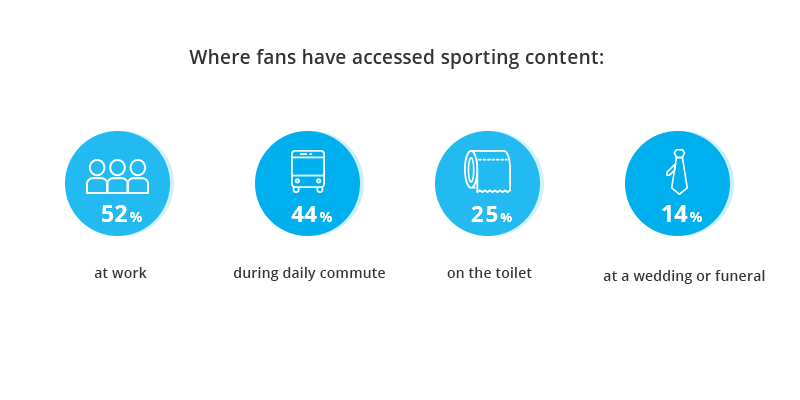
Well, whoever is without sin, cast the first stone!
[bctt tweet=”75% of people taking part in the research have watched a replay on their phone at a live venue!” username=”TellyoTV”]
Pro tip for broadcasters: Let the audience consume your content in the manner they choose and at the most convenient time for them.
Pre and after game content is crucial
Live sports broadcasts are ephemeral – they come and go at specific times. However, sports audiences are very keen to watch content before an event and after it. The day before a game or event, fan consumption of sport related videos increases by 75%, as the audience seeks information about their team and the game itself.
This represents a great opportunity for rights holders and broadcasters alike – to improve your social media presence and reach many more fans with timely content.
Pro tip for broadcasters: Plan events very carefully – don’t forget to produce some pre-event warm-up videos and post-event summaries.
The audience is tech savvy
The quality and attractiveness of content is extremely important for viewers. They want to see different types of content, including live streams, short clips, compilations, highlights etc. However, all the content you offer has to be high quality. For example, 50% of fans say that interactive slow-motion replays would improve the fan experience, and 3 in 5 want to have the ability to choose different camera angles.
While those technologies are yet to come, these responses provide more evidence that sports audiences are both tech savvy and demanding when it comes to technology’s capabilities. Also, they want to influence the way they consume videos now and in the future.
Pro tip for broadcasters: Not every breakthrough technology is going to became standard – do you remember Google Glasses? But the pace of technological changes rapid and you should always keep an eye on interesting trends. Your audience is hungry for them!
Make piracy useless
Web piracy is a huge problem for many industries, including web streaming and broadcasting businesses.
In 2015, the fight between boxing superstars Floyd Mayweather Jr. and Manny Pacquiao was streamed to about 10,000 users via Periscope, for free.
Piracy can be as simple as pointing your smartphone at a TV screen and hitting ‘go live’. And there will be thousands of people happy to watch for free, despite the poor quality and obvious piracy.

Is there a clever way to stop such piracy? While the law is on the side of rights holders, there is no silver bullet to prevent piracy. However, there are dependable things that broadcasters can do to minimise losses.
The most obvious would be to provide an attractive and affordable offer to potential viewers. Whether subscription based or pay per view, if your service is easy to access and affordable there’s a great chance that a potential pirate will choose a high-quality and convenient but paid solution. But only if that viewer is able to see the content in the way they want!
Pro tip for broadcasters: The best way to get rid of piracy is to make it obsolete. While there are regions in the world where you can’t compete with piracy, it’s important to keep your offer attractive and customised.
Keep your eyes open
Soccer, American football, basketball and cricket might be the most popular sports, but many broadcasters might be missing something that statisticians and marketers are calling ‘long tail’.
What is long tail? In relation to sports it means that there might be a number of less popular sports that when combined have a similar or perhaps an even bigger value than mainstream sports. While it would be extremely difficult to doubt the popularity of the world’s leading sports, it is worth checking what’s going on in esports, women’s soccer leagues or newer sports that are gaining popularity. It looks like the underdogs will have their day, eventually.
This is what sports fans are thinking in terms of mainstream and less popular sports:
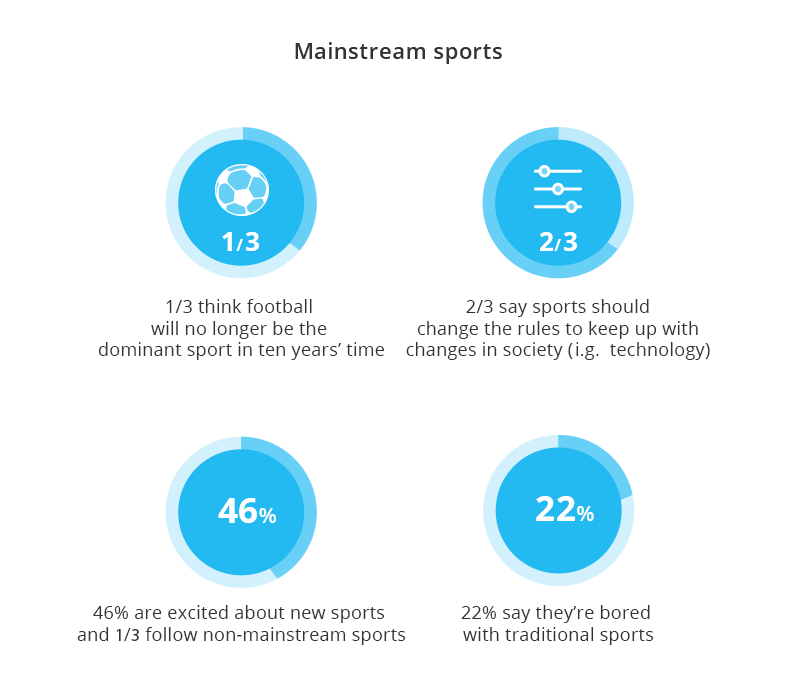
What seems pretty logical is that the home for non-mainstream sports is often on digital media platforms:
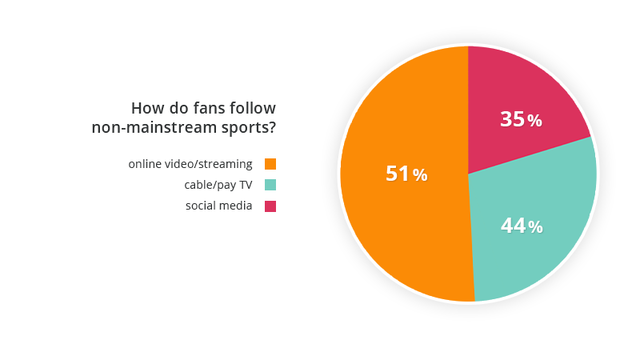
Pro tip for broadcasters: Football, soccer and basketball are leaders, while there are hundreds of ‘long tail’ sports with engaged audiences often following online and via social media. Combining these sports together could bring interesting results.
Change is the only constant
While there is not a universal strategy for sports broadcasters who are entering the social media and online world, one thing is for sure… Being immune to the changes that are occurring now is the best recipe for disaster. If you want to succeed, stay open minded and be ready for change.
You can download the report here.









